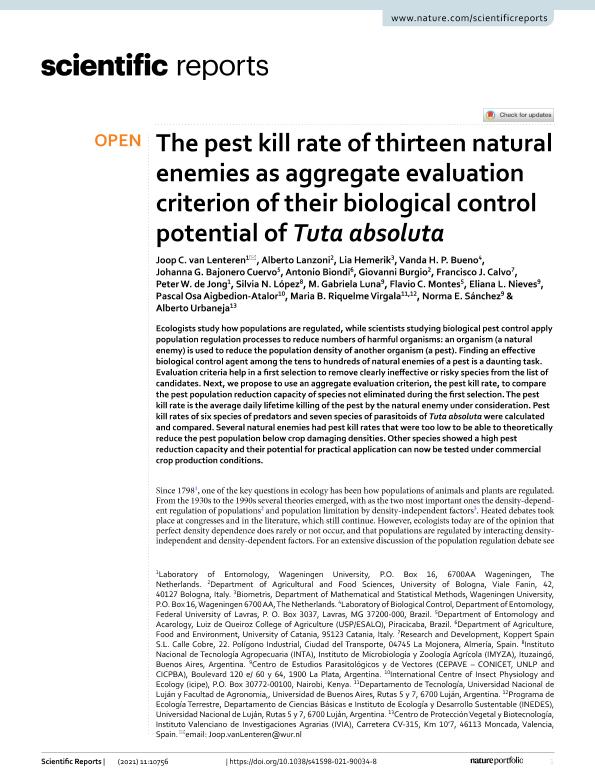Mostrar el registro sencillo del ítem
dc.contributor.author
van Lenteren, Joop C.
dc.contributor.author
Lanzoni, Alberto
dc.contributor.author
Hemerik, Lia
dc.contributor.author
Bueno, Vanda H. P.
dc.contributor.author
Bajonero Cuervo, Johanna G.
dc.contributor.author
Biondi, Antonio
dc.contributor.author
Burgio, Giovanni
dc.contributor.author
Calvo, Francisco J.
dc.contributor.author
de Jong, Peter W.
dc.contributor.author
López, Silvia Noemí

dc.contributor.author
Luna, María Gabriela

dc.contributor.author
Montes, Flavio C.
dc.contributor.author
Nieves, Eliana Lorena

dc.contributor.author
Aigbedion Atalor, Pascal Osa
dc.contributor.author
Riquelme Virgala, María Begoña

dc.contributor.author
Sanchez, Norma Elba

dc.contributor.author
Urbaneja, Alberto

dc.date.available
2022-12-14T15:34:48Z
dc.date.issued
2021-12
dc.identifier.citation
van Lenteren, Joop C.; Lanzoni, Alberto; Hemerik, Lia; Bueno, Vanda H. P.; Bajonero Cuervo, Johanna G.; et al.; The pest kill rate of thirteen natural enemies as aggregate evaluation criterion of their biological control potential of Tuta absoluta; Nature Research; Scientific Reports; 11; 1; 12-2021
dc.identifier.uri
http://hdl.handle.net/11336/181154
dc.description.abstract
Ecologists study how populations are regulated, while scientists studying biological pest control apply population regulation processes to reduce numbers of harmful organisms: an organism (a natural enemy) is used to reduce the population density of another organism (a pest). Finding an effective biological control agent among the tens to hundreds of natural enemies of a pest is a daunting task. Evaluation criteria help in a first selection to remove clearly ineffective or risky species from the list of candidates. Next, we propose to use an aggregate evaluation criterion, the pest kill rate, to compare the pest population reduction capacity of species not eliminated during the first selection. The pest kill rate is the average daily lifetime killing of the pest by the natural enemy under consideration. Pest kill rates of six species of predators and seven species of parasitoids of Tuta absoluta were calculated and compared. Several natural enemies had pest kill rates that were too low to be able to theoretically reduce the pest population below crop damaging densities. Other species showed a high pest reduction capacity and their potential for practical application can now be tested under commercial crop production conditions.
dc.format
application/pdf
dc.language.iso
eng
dc.publisher
Nature Research
dc.rights
info:eu-repo/semantics/openAccess
dc.rights.uri
https://creativecommons.org/licenses/by/2.5/ar/
dc.subject
BIOLOGICAL CONTROL
dc.subject
PARASITOID
dc.subject
PREDATOR
dc.subject
TUTA ABSOLUTA
dc.subject
KILL RATE
dc.subject.classification
Ecología

dc.subject.classification
Ciencias Biológicas

dc.subject.classification
CIENCIAS NATURALES Y EXACTAS

dc.title
The pest kill rate of thirteen natural enemies as aggregate evaluation criterion of their biological control potential of Tuta absoluta
dc.type
info:eu-repo/semantics/article
dc.type
info:ar-repo/semantics/artículo
dc.type
info:eu-repo/semantics/publishedVersion
dc.date.updated
2022-09-21T23:32:27Z
dc.identifier.eissn
2045-2322
dc.journal.volume
11
dc.journal.number
1
dc.journal.pais
Reino Unido

dc.description.fil
Fil: van Lenteren, Joop C.. Wageningen University; Países Bajos
dc.description.fil
Fil: Lanzoni, Alberto. Università di Bologna; Italia
dc.description.fil
Fil: Hemerik, Lia. Wageningen University; Países Bajos
dc.description.fil
Fil: Bueno, Vanda H. P.. Universidad Federal de Lavras; Brasil
dc.description.fil
Fil: Bajonero Cuervo, Johanna G.. Universidade do Sao Paulo. Escola Superior de Agricultura Luiz de Queiroz; Brasil
dc.description.fil
Fil: Biondi, Antonio. University of Catania; Italia
dc.description.fil
Fil: Burgio, Giovanni. Università di Bologna; Italia
dc.description.fil
Fil: Calvo, Francisco J.. Koppert; España
dc.description.fil
Fil: de Jong, Peter W.. Wageningen University; Países Bajos
dc.description.fil
Fil: López, Silvia Noemí. Instituto Nacional de Tecnología Agropecuaria. Centro de Investigación en Ciencias Veterinarias y Agronómicas. Instituto de Microbiología y Zoología Agrícola; Argentina. Consejo Nacional de Investigaciones Científicas y Técnicas; Argentina
dc.description.fil
Fil: Luna, María Gabriela. Consejo Nacional de Investigaciones Científicas y Técnicas. Centro Científico Tecnológico Conicet - La Plata. Centro de Estudios Parasitológicos y de Vectores. Universidad Nacional de La Plata. Facultad de Ciencias Naturales y Museo. Centro de Estudios Parasitológicos y de Vectores; Argentina
dc.description.fil
Fil: Montes, Flavio C.. Universidade do Sao Paulo. Escola Superior de Agricultura Luiz de Queiroz; Brasil
dc.description.fil
Fil: Nieves, Eliana Lorena. Consejo Nacional de Investigaciones Científicas y Técnicas. Centro Científico Tecnológico Conicet - La Plata. Centro de Estudios Parasitológicos y de Vectores. Universidad Nacional de La Plata. Facultad de Ciencias Naturales y Museo. Centro de Estudios Parasitológicos y de Vectores; Argentina
dc.description.fil
Fil: Aigbedion Atalor, Pascal Osa. International Centre of Insect Physiology and Ecology; Kenia
dc.description.fil
Fil: Riquelme Virgala, María Begoña. Consejo Nacional de Investigaciones Científicas y Técnicas. Oficina de Coordinación Administrativa Parque Centenario. Universidad Nacional de Luján. Instituto de Ecología y Desarrollo Sustentable; Argentina
dc.description.fil
Fil: Sanchez, Norma Elba. Consejo Nacional de Investigaciones Científicas y Técnicas. Centro Científico Tecnológico Conicet - La Plata. Centro de Estudios Parasitológicos y de Vectores. Universidad Nacional de La Plata. Facultad de Ciencias Naturales y Museo. Centro de Estudios Parasitológicos y de Vectores; Argentina
dc.description.fil
Fil: Urbaneja, Alberto. Institut Valencià D'investigacions Agràries.; España
dc.journal.title
Scientific Reports
dc.relation.alternativeid
info:eu-repo/semantics/altIdentifier/url/http://www.nature.com/articles/s41598-021-90034-8
dc.relation.alternativeid
info:eu-repo/semantics/altIdentifier/doi/http://dx.doi.org/10.1038/s41598-021-90034-8
Archivos asociados
